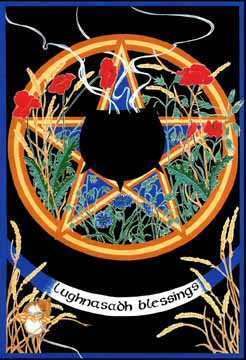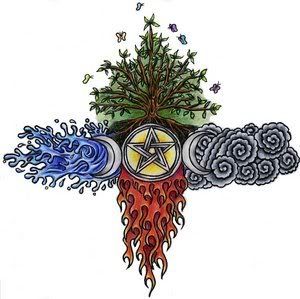Thursday, July 31, 2008
Lughnasadh
I got this in a email on myspace, so I thought it would be a good idea to post it here.
Lughnasadh (loo' na sah) or (loon' sah) - Major sabbat
Also known as Lammas
15 degrees of Leo, or August 1
Wiccan mythology: Aging God
Lughnasadh is the start of Autumn and was the time of the first harvest, and so this is a holiday of fruition and also of preparation for the oncoming winter, as well as the God's impending death. The Goddess enters her phase as Crone. It is a time of giving thanks for all that we have, all that we will have, and all that others have sacrificed for us.
Lughnasadh, also called Lammas, is the Celebration of Harvest and begins what is called "the chase of Lugh". Lugh is the Celtic Sun God and He rains down upon the crops, living within the golden fields. This is the time of the first harvests. At this celebration we give thanks to the Earth for its bounty and beauty. It is from these harvests that we eat through the upcoming winter. Honoring the God Lugh, games and sports are played to celebrate strength and good health. The grain Goddesses Demeter and Ceres are also honored. This is a time to harvest the dreams planted earlier in the year.
In Ireland in 1169, under the jurisdiction of the last High King, Ruraidh O'Conchobhar, the last Lughnasadh games, feast and fair were held. Lughnasadh or 'Festival of Lugh' was a time of thanksgiving and reverence to the Land for it's sacrifices to us. This was a time to test and give thanks for the skills and talents that we had been given and had achieved.
It is said that Lugh (Llew, Lugos, Lugus), Master of All the Arts and Crafts, dedicated this festival to his foster-mother, Tailtiu, the last queen of the Fir Bolg, who died from exhaustion after clearing a great forest so that the land could be cultivated. When the men of Ireland gathered at her death-bed, she told them to hold funeral games in her honor. As long as they were held, she prophesied Ireland would not be without song. Tailtiu's name is from Old Celtic Talantiu, "The Great One of the Earth," suggesting she may originally have been a personification of the land itself, like so many Irish goddesses. In fact, Lughnasadh has an older name, Brón Trogain, which refers to the painful labor of childbirth. For at this time of year, the earth gives birth to her first fruits so that her children might live....
The Lughnassadh Sabbat is a time to celebrate the first of three harvest celebrations (Mabon and Samhain being the other two) in the Craft. It marks the middle of Summer represents the start of the harvest cycle and relies on the early crops of ripening grain, and also any fruits and vegetables that are ready to be harvested. It is therefore greatly associated with bread as grain is one of the first crops to be harvested. Wiccans give thanks and honor to all Gods and Goddesses of the Harvest, as well as those who represent Death and Resurrection.
Lughnasadh was also the traditional time of year for craft festivals. The medieval guilds would create elaborate displays of their wares, decorating their shops and themselves in bright colors and ribbons, marching in parades, and performing strange, ceremonial plays and dances for the entranced onlookers. The atmosphere must have been quite similar to our modern-day Renaissance Festivals.
One traditional Lughnasadh custom was the construction of the kern-baby, corn dolly, or corn maiden. This figure, braided into a woman's form from the last harvested sheaf of grain, represented the Harvest Spirit. (In America, the tradition is continued in the making of corn husk dolls.) The doll would be saved until Spring, when it was ploughed into the field to consecrate the new planting and insure a good harvest. In other traditions, the corn dolly was fed and watered throughout the Winter, then burned in the fires at Beltane to insure a continuation of good growth.
Another custom drawn from Lughnasadh relates to fire. Lughnasadh was, to the Celts, one of four Great Fire Festivals, held on the cross-quarter days. During Lughnasadh, the custom of lighting bonfires was intended to add strength to the powers of the waning sun. Afterward, the fire brands were kept in the home through the Winter as protection against storms, lightning and fires caused by lightning....
It is customary to consume bread or something from the First Harvest during the Lughnassadh Ritual. Other actions include the gathering of first fruits and the study of Astrology. Some Pagans symbolically throw pieces of bread into a fire during the Lammas ritual. The celebration of Lammas is a pause to relax and open yourself to the change of the Season so that you may be one with its energies and accomplish what is intended. Visits to fields, orchards, lakes and wells are also traditional. It is considered taboo not to share your food with others. Spellwork for prosperity, abundance and good fortune are especially appropriate now, as well as spells for connectedness, career, health and financial gain.
Activities appropriate for this time of the year are the baking of bread and wheat weaving - such as the making of Corn Dollies, or other God & Goddess symbols. Sand candles can be made to honor the Goddess and God of the sea. You may want to string Indian corn on black thread to make a necklace, and bake corn bread sticks shaped like little ears of corn for your Sabbat cakes. The Corn Dolly may be used both as a fertility amulet and as an altar centerpiece. Some bake bread in the form of a God-figure or a Sun Wheel - if you do this, be sure to use this bread in the Cakes and Ale Ceremony.
As summer passes, Wiccans remember its warmth and bounty in the food we eat. Every meal is an act of attunement with Nature, and we are reminded that nothing in the Universe is constant.
May the Lord and Lady bless you all with lots of love, and a plentiful First Harvest!
Lughnasadh Correspondences
(Loo-nas-ah) Major Sabbat (High Holiday) - Fire Festival August 1, 2
Other Names: Lunasa (meaning August), Lughnasaad, Lughnasa Celtic),First Harvest, August Eve, Feast of Cardenas, Feast of Bread, Tailltean Games(Irish), Teltain Cornucopia (Strega), Ceresalia (Ancient Roman) Harvest Home, Thingtide (Teutonic), Lammas (Christian), Laa Luanys, Elembious, Festival of Green Corn (Native American)
Animals and Mythical beings: Griffins, Basilisks, Roosters, Calves, Centaurs, Phoenix Gemstones: aventurine, citrine, peridot, sardonyx, yellow diamonds, citrine
Incense and Oils: wood aloes, rose, rose hips, rosemary, chamomile, eucalyptus, safflower, corn, passionflower, frankincense, sandalwood
Colors: red, orange, golden yellow, green, light brown, gold, bronze, gray
Tools, Symbols, and Decorations: corn, cornucopias, red, yellow flowers, sheaves of grain (wheat, barley, oats), first fruits/vegetables of garden labor, corn dollies, baskets of bread, spear, cauldron, sickle, scythe, threshing tools, sacred loaf of bread, harvested herbs, bonfires, bilberries, God figures made of bread or cookie dough, phallic symbols Goddesses: The Mother, Dana (Lugh&'s wife & queen ), Tailltiu (Welsh-Scottish), Demeter (Greek), Ceres (Roman grain goddess .. honored at Ceresalia), the Barley Mother, Seelu (Cherokee), Corn Mother, Isis (Her birthday is celebrated about this time), Luna (Roman Moon Goddess), other agricultural Goddesses, the waxing Goddess
Gods: Lugh (Celtic, one of the Tuatha De Danaan), John Barley Corn, Arianrhod's golden haired son Lleu (Welsh God of the Sun & Corn where corn includes all grains, not just maize), Dagon (Phoenician Grain God), Tammuz/ Dummuzi (Sumerian), Dionysus, plus all sacrificial Gods who willingly shed blood/give their life that their people/lands may prosper, all vegetation Gods & Tanus (Gaulish Thunder God), Taranis (Romano-Celtic Thunder God), Tina, (Etruscan-Thunder God), the waning God
Essence: fruitfulness, reaping, prosperity, reverence, purification, transformation, change, The Bread of Life, The Chalice of Plenty , The Ever-flowing Cup , the Groaning Board (Table of Plenty)
Meaning: Lugh's wedding to Mother Earth, Birth of Lugh; Death of Lugh, Celtic Grain Festival
Purpose: Honoring the parent Deities, first harvest festival, first fruits grains & drink to the Goddess in appreciation of Her bounty, offering loaves of sacred bread in the form of the God (this is where the Gingerbread Man originated)
Rituals and Magicks: astrology, prosperity, generosity, continued success, good fortune, abundance, magickal picnic, meditate & visualize yourself completing a project you've started
Customs and Activities: games, the traditional riding of poles/staves, country fairs, breaking bread with friends, making corn dollys, harvesting herbs for charms/rituals, Lughnasadh fire with sacred wood & dried herbs, feasting, competitions, lammas towers (fire-building team competitions), spear tossing, gathering flowers for crowns, fencing/swordplay, games of skill, martial sports, chariot races, hand-fastings, trial marriages, dancing 'round a corn mother (doll)
Foods: loaves of homemade wheat, oat, & corn bread, barley cakes, corn, potatoes, summer squash, nuts, acorns, wild berries (any type), apples, rice, pears, berry pies, elderberry wine, crab apples, mead, crab, blackberries, meadowsweet tea, grapes, cider, beer
Herbs: grain, acacia, heather, ginseng, sloe, cornstalks, cyclamen, fenugreek, aloes, frankincense, sunflower, hollyhock, oak leaf, wheat, myrtle Element: Fire
Gender: Female
Threshold: Noon
An Introduction of a Witch
Ok, well this is my first post. This is something I have always wanted to do, but just seem to never get around to starting a blog. So today is the day! As for an introduction of myself, my name is Erin. I have been studying Paganism, Wicca, Druidism and all things spiritual for almost as long as I can remember. I always felt lost within the Christian church. My Grandparents being Lutheran/Methodist and my mother reading me stories of Greek mythology. Therefore, by the time I was 12 I was deeply rooted in nature and all things magical, but still could not understand it. Though one of the most unrealistic movies opened my eyes to Wicca is an odd way. The movie The Craft, though not about Wicca at all, it started me down the path of reading books on Witchcraft which in turn lead me to Wicca.
So, through the years I have read lots of books. Stopped and changed my religion (like an IDIOT) for a man. After a few years of not feeling right, it all culminated with a freak out going to work last winter. Never burn the candle at both ends, it doesn’t leave you much! For the past 4 months I have been doing deep inner seeking and rereading some of my favorites and trying some new books out as well. Oddly enough, I feel like I am starting all over again, which I guess is the truth.
So… I guess stay tuned for more blogs about my discoveries and journey as a Solitary Witch.




